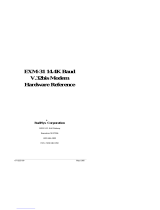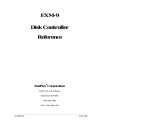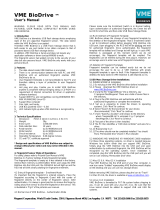Page is loading ...

____________________________________________________________________
07-0870-01 October 1998
EPC-5A
Hardware & Software
Reference Manual
RadiSys Corporation
5445 NE Dawson Creek Drive
Hillsboro, Oregon 97124
Phone: (503) 615-1100
Fax: (503) 615-1150
http://www.radisys.com

EPC-5A Hardware & Software Reference Manual
Page ii
EPC, iRMX, INtime, Inside Advantage and RadiSys are registered trademarks of
RadiSys Corporation. Spirit, DAI, DAQ, ASM, Brahma and SAIB are trademarks of
RadiSys Corporation.
All other trademarks, registered trademarks, service marks, and trade names are the
property of their respective owners.
October 1998
Copyright 1998 by RadiSys Corporation
All rights reserved.

EPC-5A Hardware & Software Reference Manual
Page iii
Hardware Warranty
RadiSys Corporation ("RadiSys") warrants the EPC system and component modules
to the original purchaser for two years from the product’s shipping date. If an EPC
product fails to operate in compliance with its specification during this period,
RadiSys will, at its option, repair or replace the product at no charge. The customer
is, however, responsible for shipping the product; RadiSys assumes no responsibility
for the product until it is received. This warranty does not cover repair of products
that have been damaged by abuse, accident, disaster, misuse, or incorrect installation.
RadiSys’ limited warranty covers products only as delivered. User modification, such
as the addition of memory arrays or other devices, may void the warranty, and if the
product is damaged during installation of the modifications, this warranty does not
cover repair or replacement.
This warranty in no way warrants suitability of the product for any specific
application.
IN NO EVENT WILL RADISYS BE LIABLE FOR ANY DAMAGES,
INCLUDING LOST PROFITS, LOST SAVINGS, OR OTHER INCIDENTAL OR
CONSEQUENTIAL DAMAGES ARISING OUT OF THE USE OR INABILITY TO
USE THE PRODUCT EVEN IF RADISYS HAS BEEN ADVISED OF THE
POSSIBILITY OF SUCH DAMAGES, OR FOR ANY CLAIM BY ANY PARTY
OTHER THAN THE PURCHASER.
THE ABOVE WARRANTY IS IN LIEU OF ANY AND ALL OTHER WAR-
RANTIES, EXPRESSED OR IMPLIED OR STATUTORY, INCLUDING THE
WARRANTIES OF MERCHANTABILITY, FITNESS FOR A PARTICULAR PUR-
POSE OR USE, TITLE AND NONINFRINGEMENT. Repair or replacement as pro-
vided above shall be the Purchaser’s sole and exclusive remedy and RadiSys’ exclusive
liability for any breach of warranty.

EPC-5A Hardware & Software Reference Manual
Page iv
Table of Contents
1. Product Description................................................................................................1
Purpose..................................................................................................................1
About this Manual.................................................................................................1
Notational Conventions.........................................................................................2
Product Overview..................................................................................................3
Specifications........................................................................................................4
Differences Between EPC-5 and EPC-5A.............................................................4
2. Before Installation ...................................................................................................7
Configuring the EPC-5A.......................................................................................7
Selecting the EPC-5A Slot Location.....................................................................8
Installing the VMEbus Backplane Jumpers...........................................................10
Jumpers .................................................................................................................14
3. Installation................................................................................................................15
Subplane Installation.............................................................................................15
EXP-BP2 Subplane.......................................................................................16
EXP-BP4 Subplane.......................................................................................17
EXP-BP3A Subplane....................................................................................18
EXP-BP5 Subplane.......................................................................................19
EXP-BP4A Subplane....................................................................................20
EXP-BP6 Subplane.......................................................................................21
EPC-5A Insertion..................................................................................................22
EXP-MC Module Carrier Insertion.......................................................................23
EXP-MX Mass Storage Module Insertion.............................................................24
EXM Module Insertion .........................................................................................24
Connecting Peripherals to the EPC-5A .................................................................25
Monitor.........................................................................................................25
Keyboard ......................................................................................................25
Serial Ports....................................................................................................26
Parallel Printer Port ......................................................................................26
EXP-MX Ports..............................................................................................26
4. BIOS Configuration.................................................................................................27
Introduction...........................................................................................................27
BIOS Setup Screens..............................................................................................27
Main BIOS Setup Menu........................................................................................29
IDE Adapter Sub-menus...............................................................................31
Memory Shadow Sub-Menu.........................................................................33
Boot Options Sub-menu................................................................................34
Keyboard Features Sub-menu.......................................................................36

EPC-5A Hardware & Software Reference Manual
Page v
Advanced Menu ....................................................................................................37
EXM Menu............................................................................................................39
VME Menu............................................................................................................42
Exit Menu..............................................................................................................44
5. Theory of Operation...............................................................................................47
Processor board.....................................................................................................47
Processor and Coprocessor...........................................................................47
Core Logic.............................................................................................................47
Memory ........................................................................................................48
Memory Map................................................................................................48
Peripheral Components .........................................................................................50
Real Time Clock....................................................................................................50
Keyboard Controller..............................................................................................51
ROM and ROM Shadowing..................................................................................51
Embedded Shadow................................................................................................51
Bootable Device Precedence.................................................................................51
Battery...................................................................................................................52
Video Controllers..................................................................................................53
Front Panel LEDs..................................................................................................53
Resetting the EPC-5A ...........................................................................................54
EXM Expansion Interface.....................................................................................54
6. The VMEbus Interface...........................................................................................57
Connectivity..........................................................................................................57
VMEbus System (Slot-1) Controller Functions.....................................................57
Concepts................................................................................................................58
Memory Map................................................................................................58
Direct VMEbus Accesses .............................................................................59
Byte Ordering...............................................................................................60
Slave Accesses from the VMEbus................................................................63
Self Accesses Across the VMEbus...............................................................64
Read-Modify-Write Operations....................................................................64
VMEbus Interrupt Response.........................................................................65
Registers Specific to the EPC-5A..........................................................................66
VMEbus Mapped Registers..........................................................................77
Register State after Reset..............................................................................78
Supported Address Modifiers................................................................................78
Low-Level Programming the VMEbus Interface ..................................................79
VMEbus Accesses........................................................................................79
Low-Level Handling of VMEbus Interrupts.................................................82
7. Connectors...............................................................................................................87
Serial Ports............................................................................................................87

EPC-5A Hardware & Software Reference Manual
Page vi
Parallel Port...........................................................................................................88
Keyboard...............................................................................................................88
Speaker Header .....................................................................................................89
Battery Header ......................................................................................................89
8. Upgrades..................................................................................................................91
Memory.................................................................................................................91
9. Troubleshooting & Error Messages ......................................................................93
Troubleshooting ....................................................................................................93
Common Error Messages......................................................................................95
Boot Failures.........................................................................................................101
Phoenix NuBIOS Checkpoints ..........................................................................102
10. Support and Service..............................................................................................107
In North America ..................................................................................................107
Technical Support.........................................................................................107
World Wide Web..........................................................................................107
Repair Services.............................................................................................108
Warranty Repairs..........................................................................................108
Non-Warranty Services.................................................................................108
Arranging Service.........................................................................................109
Other Countries.....................................................................................................110
Appendix A: Chip Set & I/O Map..............................................................................A-1
Appendix B: Interrupts and DMA Channels ............................................................B-1
Interrupts...............................................................................................................B-1
DMA Channels......................................................................................................B-2
Appendix C: Flash Boot Device..................................................................................C-1
Flash Boot Device Reflashing...............................................................................C-3
Reflashing using REFLASH.EXE.........................................................................C-6
User BIOS Extensions...........................................................................................C-8
PicoCard Flash File System...................................................................................C-9
Appendix D: PFormat .................................................................................................D-1
Appendix G: Glossary

EPC-5A Hardware & Software Reference Manual
Page vii
List of Illustrations
Figure 2-1. Slot-1 Jumper Location............................................................................... 8
Figure 2-2. Daisy-Chain Signal Concept ....................................................................... 10
Figure 2-3. Backplane Jumpers Required for EPC-5A Subsystem................................ 11
Figure 2-4. VMEbus Backplane Jumper Examples ....................................................... 12
Figure 2-5. VMEbus Jumpers on Rear Wirewrap Pins.................................................. 13
Figure 2-6. VMEbus Jumpers on Front Stake Pins........................................................ 13
Figure 3-1. EXP-B2 Backplane ..................................................................................... 16
Figure 3-2. EXP-BP4 Subplane..................................................................................... 17
Figure 3-3. EXP-BP3A Subplane .................................................................................. 18
Figure 3-4. EXP-BP5 Subplane..................................................................................... 19
Figure 3-5. EXP-BP4A Subplane .................................................................................. 20
Figure 3-6. EXP-BP6 Subplane..................................................................................... 21
Figure 3-7. EXP-MC Module Carrier (side view) ......................................................... 23
Figure 4-1. BIOS Setup Menu Map............................................................................... 28
Figure 4-2. Main BIOS Setup Menu.............................................................................. 29
Figure 4-3. IDE Adapter Sub-menu .............................................................................. 31
Figure 4-4. Memory Shadow Menu............................................................................... 33
Figure 4-5. Boot Options Sub-Menu.............................................................................. 34
Figure 4-6. Keyboard Features Sub-menu ..................................................................... 36
Figure 4-7. Advanced Menu .......................................................................................... 37
Figure 4-8. EXM Menu.................................................................................................. 39
Figure 4-9. Slot Numbering........................................................................................... 40
Figure 4-10. VME Setup Menu...................................................................................... 42
Figure 4-11. Exit Menu.................................................................................................. 44
Figure 6-1. Source of VMEbus Address Lines (Via E-page)......................................... 58
Figure 6-2. Source of VMEbus Address Lines (Via Direct Mapping)........................... 60
Figure 6-3. Little-Endian Byte Order............................................................................. 61
Figure 6-4. Big-Endian Byte-swapping.......................................................................... 62
Figure 8-1. SIMM Memory Location ............................................................................ 92
Figure C-1. Flash Boot Device Memory Map................................................................C-2
Figure C-2. Flash Boot Device Recovery Mechanism...................................................C-5
Figure C-3. PicoCard Flash File System........................................................................C-9

EPC-5A Hardware & Software Reference Manual
Page viii
List of Tables
Table 1-1. EPC-5A Environmental and Electrical Specifications.................................. 4
Table 2-1. VME Slots Available.................................................................................... 9
Table 2-2. EPC-5A Jumpers .......................................................................................... 13
Table 5-1. R400EX Features ......................................................................................... 48
Table 6-1. Direct Mapping............................................................................................. 59
Table 7-1. Serial Port Pinout ......................................................................................... 87
Table 7-2. Parallel Port Pinout....................................................................................... 88
Table 7-3. Keyboard Connector Pinout ......................................................................... 88
Table 7-4. Speaker Header Pinout................................................................................. 89
Table 7-5. Battery Header Pinout .................................................................................. 89
Table 9-1. Phoenix NuBIOS Checkpoint Codes............................................................104
Table 9-2. Phoenix NuBIOS Auxiliary Checkpoint Codes............................................105
Table 9-3. Phoenix NuBIOS Boot Block Checkpoint Codes.........................................105
Table B-1. Interrupts......................................................................................................B-1
Table B-2. DMA Channels ............................................................................................B-2
Table C-1. FBD Object Placement ................................................................................C-3

Page 1
11
1. Product Description
Purpose
This manual was written to provide detailed hardware reference information for
OEMs, system integrators, and other engineers using the EPC-5A as a component of
their VMEbus systems. The reader should be able to install the EPC-5A and configure
the system based on the information in this manual.
About this Manual
This manual assumes that the reader has good familiarity with PC systems based on
the Intel x86 architecture and familiarity with VMEbus architecture. For more
information about EPConnect, which is the RadiSys programming interface to the
Microsoft Windows APIs, consult the appropriate EPConnect/VME manual.
The information in this manual is organized into the following sections:
Front Matter Warranty Information, Table of Contents, List of Figures and Tables.
Chapter 1 Product Description. Provides an introduction to the EPC-5A, a brief
description of the features provided, and a table of specifications.
Chapter 2 Before Installation. Covers the details of configuring the EPC-5A,
selecting the proper slot location, and installing backplane jumpers.
Chapter 3 Installation. Describes the process installing the EPC-5A in a VME
mainframe using a subplane, and connecting peripherals.
Chapter 4 Configuring the BIOS Setup. Provides detailed information about
how to configure the EPC-5A’s BIOS.
Chapter 5 Theory of Operation. Describes the processor board, memory, ROM
shadowing, video, front panel LEDs, and EXM expansion.

EPC-5A Hardware & Software Reference Manual
Page 2
11
Chapter 6 Programming the VMEbus Interface. Describes Slot-1 controller
functions, slave- and self-accesses, and initializing and programming
the VMEbus interface.
Chapter 7 Connectors. Describes pinouts for the serial and parallel port
connectors, plus the keyboard, speaker, and battery headers.
Chapter 8 Upgrades. Lists possible memory upgrades for the EPC-5A.
Chapter 9 Troubleshooting and Error Messages. Describes various error
conditions and recovery procedures.
Chapter 10 Support and Service. Provides contact information for RadiSys
Technical Support.
Appendix A Chipset and I/O Map.
Appendix B Interrupts and DMA Channels.
Appendix C Flash Boot Device.
Appendix D Pformat. For use with EXM-2A.
Appendix G Glossary. A guide to terminology and acronyms used in this manual.
Notational Conventions
The following notational conventions are used throughout this manual.
FFh Hexadecimal numbers are indicated by an “h” suffix.
* In signal definitions, the asterisk (*) following a signal name
indicates an active low signal; for example IOCHECK*.
✏Note
Notes are used to provide the reader with important information
or explanatory information.
▲
▲
!CAUTION
Cautions are used to indicate the potential for equipment
damage, software failure, or minor personal injury.
▲
!WARNING
Warnings are used to indicate potential risk of serious
physical harm or injury.

Chapter 1: Product Description
Page 3
11
Product Overview
The EPC-5A is a PC/AT compatible embedded CPU module containing the
following:
•100 MHz Intel486 DX4 processor
•RadiSys R400EX chipset
•16 Kbytes of cache and math co-processor on-chip
•4 MB to 256 MB of DRAM memory
•Keyboard interface
•2 standard 9-pin DTE serial ports (COM1 & COM2)
•1 standard output-only parallel port (LPT1)
•Time-of-day clock with user-replaceable battery
•Phoenix 486 BIOS version 4.05
•VMEbus interface
•EXM expansion interface
The EPC-5A form factor has been designed to the VMEbus specification (6U). It
provides direct communication to all three VMEbus address spaces (A32, A24, &
A16). The EPC-5A DRAM permits dual-ported access from both the PC side and the
VME side.
The EXM expansion interface is electrically similar to the 16-bit PC/AT ISA bus.
Video is provided through an add-in card called an EXM (EXpansion Module). Mass
storage can be added via the EXP-MX Mass Storage module inside the VME chassis
or externally via other EXMs that provide an IDE or a SCSI interface. Other EXMs
are available to provide additional peripherals such as serial ports (RS232 or RS422),
an internal modem, flash memory (and accompanying flash file system drivers),
timer/counter, PCMCIA adapter and Ethernet controllers. Also, an adapter module
(EXP-AM) can be used to install a single 8-bit PC/AT add-in short card.

EPC-5A Hardware & Software Reference Manual
Page 4
11
Specifications
Environmental
Temperature operating 0° to 60° C
storage -40° to 85° C
Humidity operating 5 - 95% (non-condensing)
storage 5 - 95% (non-condensing)
Vibration operating .015"PP 2.5g (max) 5-2000 Hz
storage .030"PP 5g (max) 5-2000 Hz
Shock operating 30g 11 msec duration
storage 50g 11 msec duration
Electrical +5V +12V -12V
100 MHz - DX4 maximum 6.5 A *100 mA 100 mA
typical 5.5 A *100 mA 100 mA
*Use of the P2 connector is recommended to support the current requirements of
the EPC5A.
Table 1-1. EPC-5A Environmental and Electrical Specifications.
Differences Between EPC-5 and EPC-5A
The EPC-5A differs from the EPC-5 in the following ways:
1. The System BIOS is based on Phoenix Technologies NuBIOS revision
4.05. The EPC-5 uses an Award BIOS.
2. The EXP-MS SCSI module is not supported.
3. BIOS setup configuration is available only during the boot sequence, it
is not available after the OS boots. The CTRL-ALT-ESC key sequence
no longer invokes setup.
4. The EPC-5A supports CMOS Save and Restore (CSR) that allows
backup and restoration of the contents of CMOS RAM to and from the
Flash Boot Device (FBD).
5. Flash File System (FFS) support for flash EXMs is based on Phoenix
Technologies PicoFlash and includes read/write capability. The Xformat
based FFS is no longer supported for flash. It is still used for SRAM and
VME boot image creation.Use the Pformat utility that ships with this
product.

Chapter 1: Product Description
Page 5
11
6. Support for “User BIOS Extensions” which allows, through BIOS
extensions, booting from VME or EXM-2A, etc. Note that EXM-2A’s
are supported while the EXM-2 is not.
7. The System BIOS supports disk autotyping and disks larger than 528MB
capacity.
8. The Flash File System can be installed as a DOS device driver, therefore
flash can be installed as the second drive even when SCSI is the boot
device (EXM-16).
9. IRQ 12 is only available to the EXMBus as a build-time option.
10. Slave memory is mapped to the VME bus in the following increments:
2MB, 4MB, 8MB, 10MB, 16MB, 32MB, 64MB. However, system
memory increments are no longer restricted to this set.
11. AT bus mastering is not supported.

EPC-5A Hardware & Software Reference Manual
Page 6
11
NOTES

Page 7
22
2. Before Installation
Unpack the EPC-5A and inspect it for shipping damage.
▲
▲
!CAUTION
Do not remove the EPC-5A module from its anti-static bag
unless you are in a static-free environment.
The EPC-5A, like most electronic devices, is susceptible to electrostatic discharge
(ESD) damage. ESD damage is not always immediately obvious. It can cause a
partial breakdown in semiconductor devices that might not result in immediate failure.
Configuring the EPC-5A
The EPC-5A can be user-configured to provide standard VMEbus Slot-1
functionality. The Slot-1 configuration option is enabled (default) by installing the
Slot-1 shunt (jumper) on the processor board (see Figure 1, page 4). Removing the
jumper disables Slot-1 functionality. When the EPC-5A is configured as the Slot-1
controller, it performs all the standard VMEbus system control functions. See
Chapter 5, Theory of Operation, for more details on Slot-1 controller functions.

EPC-5A Hardware & Software Reference Manual
Page 8
22
Slot-1 Controller
Jumper
P1
P2
Front
Panel
JP1
Jumpers
Figure 2-1. Slot-1 Jumper Location.
Additionally, the EPC-5A has another jumper (see Figure 2-1 above) that rarely needs
to be changed - the MODID jumper on JP1. The EPC-5A uses pin 30, Row A of the
P2 connector for module identification. If the J2 backplane is other than a standard
VME or VXI backplane (e.g., a VSB backplane) or Pin 30, Row A is defined for
another purpose, remove this jumper.
Selecting the EPC-5A Slot Location
There are two main considerations in determining where the EPC-5A should be
positioned in the chassis.
•When used as a Slot-1 controller, and per the VMEbus specification (Rule
3.3), a Slot-1 controller must be in Slot 1. All other boards must be to the
right of the Slot-1 controller.
•The EPC-5A connects to its peripherals via a subplane which extends to the
right of the EPC-5A. Make sure that the location you choose provides
sufficient room for all the attached peripherals (EXMs and mass storage
module).

Chapter 2: Before Installation
Page 9
22
The EPC-5A plus EXM expansion modules plus any mass storage module can be
considered together as a single subsystem. Use the following worksheet to determine
the total number of VME expansion interface slots your particular subsystem
configuration requires.
Product VME Slots Total
EPC-5A
(Includes first two EXM modules) 2
Additional EXP-MC(s)
(Holds additional two EXM modules) 1
each
EXP-AM 2
Mass Storage Module (EXP-MX
including EXP-MX200A and greater) 2
or
EXP-MX200 3
Total VMEbus slots used ...........................
Table 2-1. VME Slots Available.
Once you have determined where the EPC-5A subsystem will be physically located in
the chassis, the VME backplane must be jumpered appropriately.

EPC-5A Hardware & Software Reference Manual
Page 10
22
Installing the VMEbus Backplane Jumpers
The VMEbus specification provides four bus grant signals (BG0 - BG3) and one
interrupt acknowledge signal (IACK) via daisy-chain lines. Per the VMEbus
specifications, all boards (that plug into the backplane) are required to correctly
handle these signals. All slots that do not have a board plugged into the backplane
(i.e. empty slots and slots occupied by EXMs or mass storage modules), need to be
jumpered to allow the signals to pass through to other boards in the system.
xxxOUT
xxxIN
xxxOUT
xxxIN
xxxOUT
xxxIN
VMEbus Slots
xxxIN
xxxOUT
Figure 2-2. Daisy-Chain Signal Concept.
The Slot-1 controller board initiates each daisy-chain signal. Each VMEbus slot to
the right of the Slot-1 controller must pass through each of the daisy-chain signals.
For each VMEbus slot, xxxIn pin must be connected to its corresponding xxxOut
pin (e.g. BG0In to BG0Out, BG1In to BG1Out,...,IackIn to IackOut)
either through the board in that slot or by jumpers. Some boards correctly pass all of
these signals, some boards handle some of these signals and not others, and some
boards (typically “dumb” slave boards) may not handle any of these signals. Check
the manual for each board to be installed to determine if these signals are passed
through correctly. If they are not, or if the VMEbus slot is empty, all (or some) of
these signals must be jumpered. See the following figures for examples.

Chapter 2: Before Installation
Page 11
22
indicates jumper needed
Figure 2-3. Backplane Jumpers Required for EPC-5A Subsystem.
The figure above shows the EPC-5A subsystem. Note that the left-most slot
does not require any jumpers. All other slots occupied by the subsystem
require all five jumpers be installed.

EPC-5A Hardware & Software Reference Manual
Page 12
22
Single Board Computer
that only handles
IACK & BG3
"Dumb" Slave
Does not handle
any of the signals
BG0
BG1
BG2
BG3
IACK
Figure 2-4. VMEbus Backplane Jumper Examples.
Once you have determined where the jumpers need to be, you must determine how to
jumper your particular backplane. Different backplane manufacturers handle this in
different ways; some provide stake pins on the rear of the backplane while others
provide stake pins on the front of the backplane. These stake pins can be located in
several different places.
/




